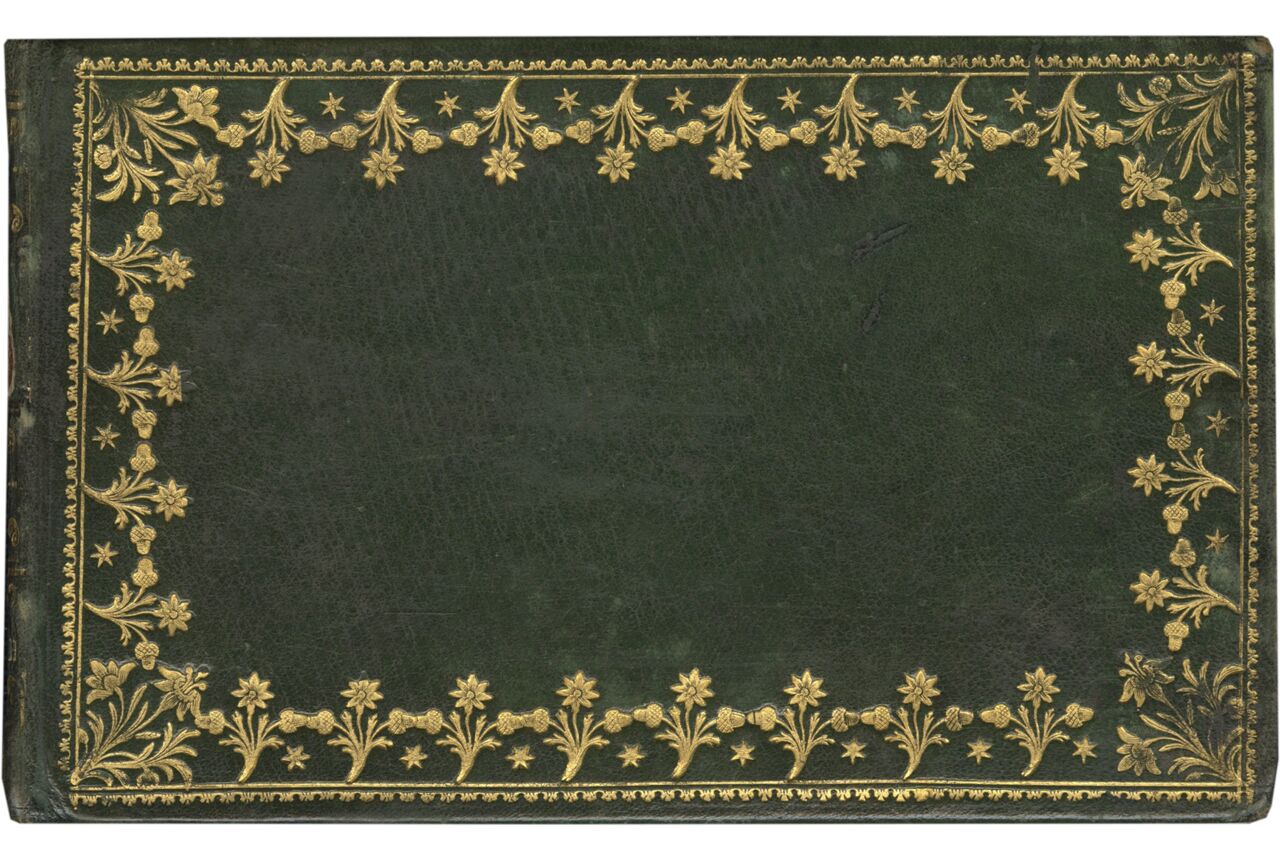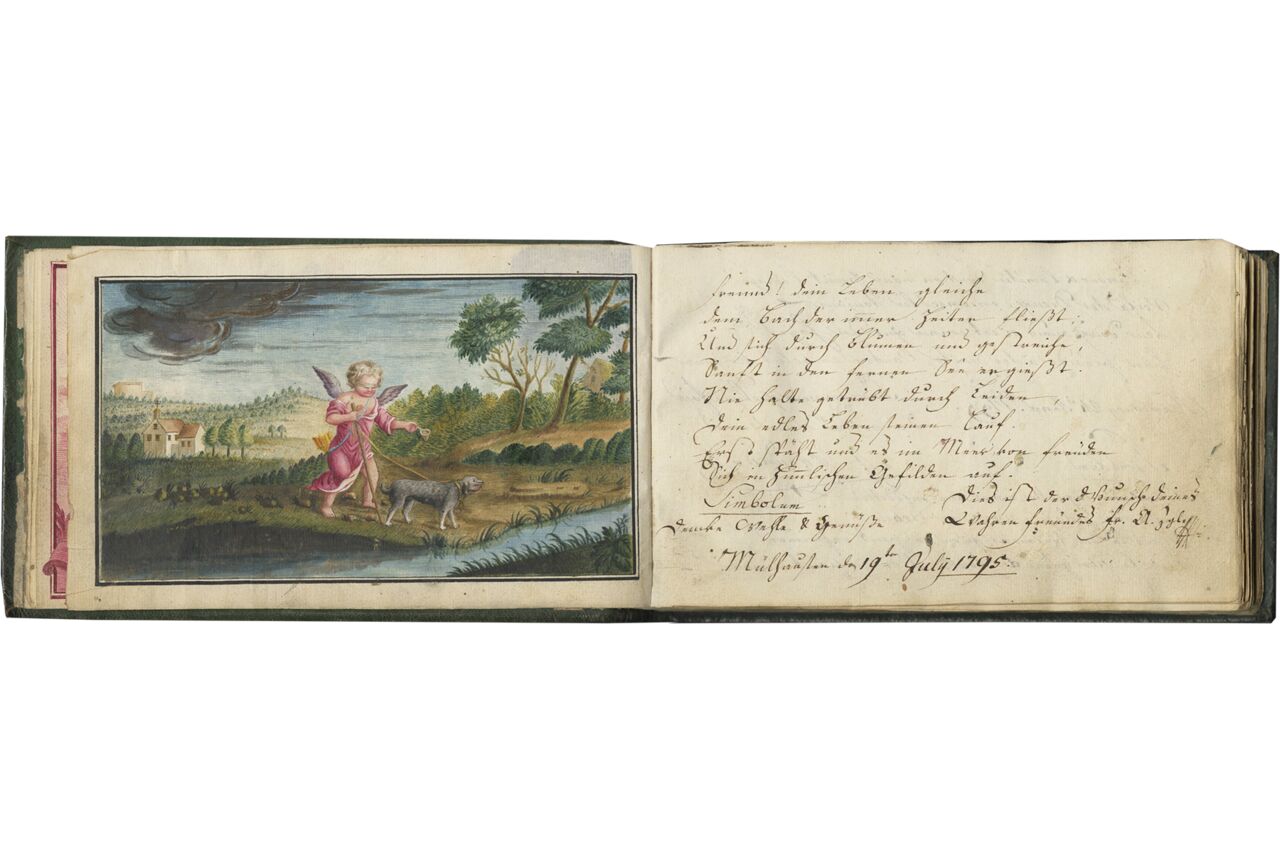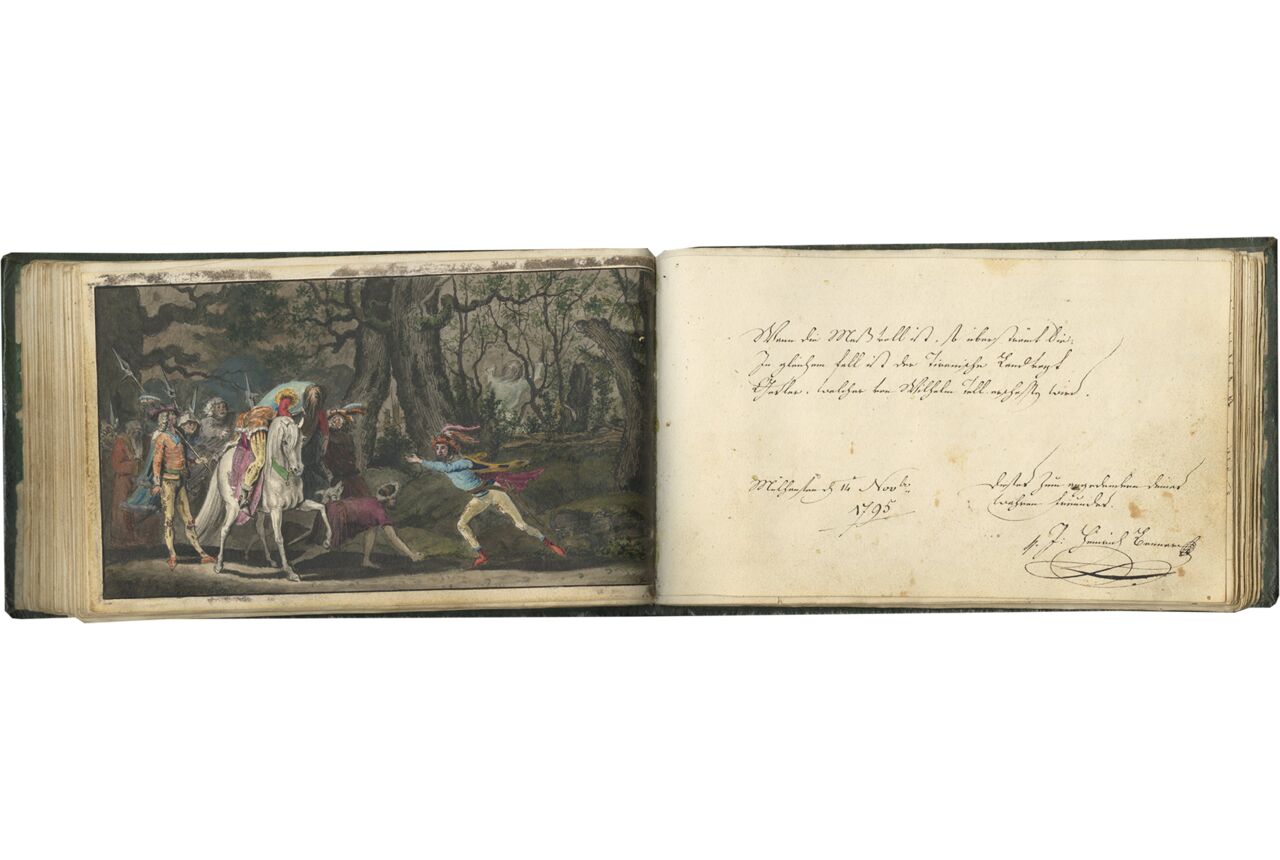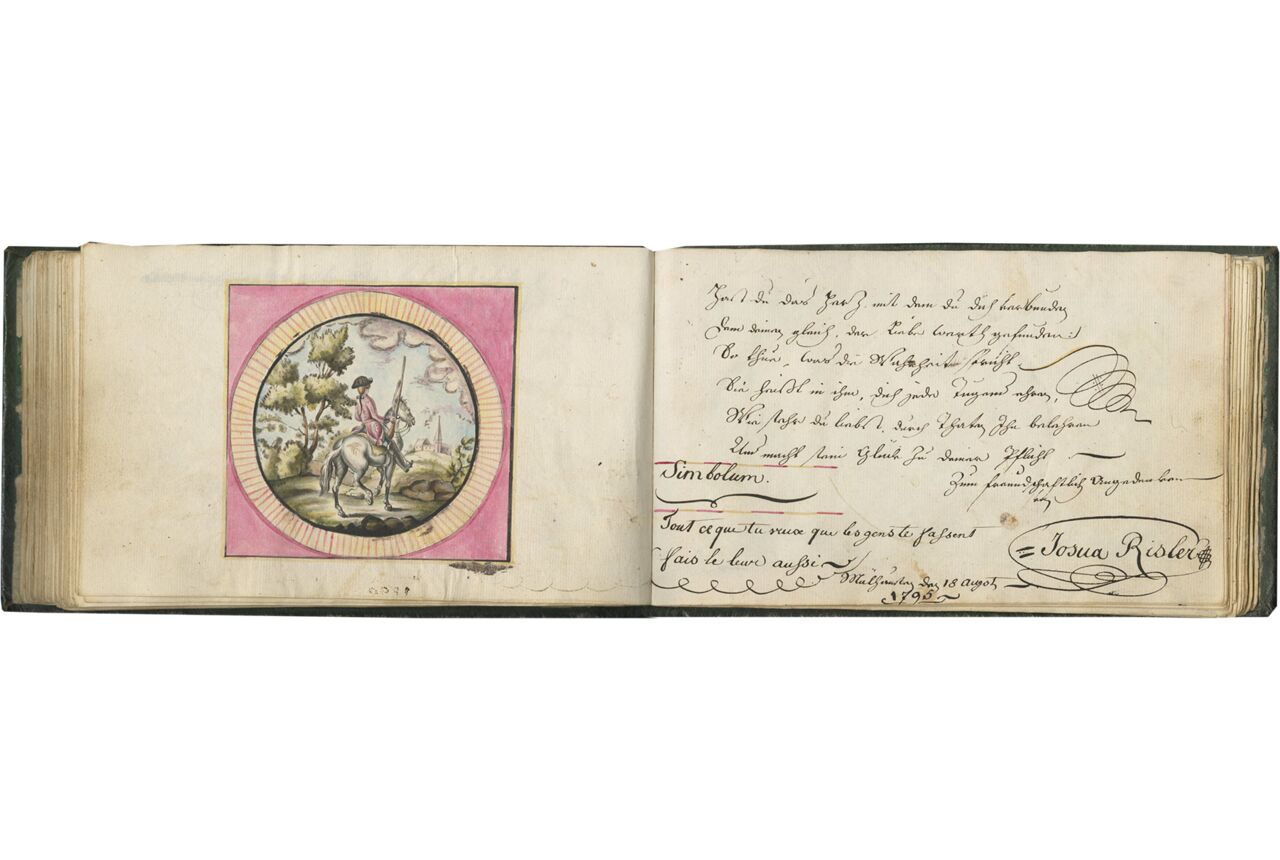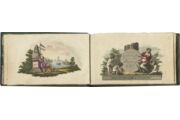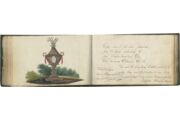i + 137 + i folios on paper, watermark “Pieter de ...,” modern foliation in pencil, 1-137, two leaves cut out (before ff. 94 and 119), SIXTEEN WATERCOLORS, SEVEN COPPER ETCHINGS PRINTED IN COLOR, SOME ENHANCED IN PEN AND INK DRAWING OR IN WATERCOLOR, FOUR PEN AND INK DRAWINGS, TWO SHADOW SILHOUETTES, ONE EMBROIDERY, some minor stains, in overall excellent condition. In its original binding of green morocco over pasteboards, covers gold-tooled with a very fine frame of acorns, flowers, small stars and cusped dentelle, flat spine richly gold-tooled with strawberries, curving foliage and fillets, spine label in red morocco titled in gilt “(D)enckmal der (F)reundschaf(t)” (worn off on the sides), marbled endpapers and pastedowns, edges gilt, minor wear to leather, in overall excellent condition. Dimensions 110 x 180 mm.
This Album Amicorum is an immensely rich volume collecting around one hundred souvenirs from friends and family of Jean de Sean Hartmann. The entries include especially fine watercolors, colored prints, and pen and ink drawings, many representing fascinating allegorical scenes. Signed works include illustrations by J. Hugenij (f. 24) and Ferdinand Ebert (f. 41v). The manuscript provides an interesting insight into social networking within the circles of European aristocracy at turn of the nineteenth century.
Provenance
1.The album was made for Jean de Sean Hartmann, starting in the year 1795, as stated on the titlepage on f. 3. The entries continue until the year 1806 and were made in a number of cities in Germany, France, Poland and Switzerland, mainly in Berlin, Mulhouse and Hamburg.
Illustration
ff. 2v-3, Diptych titlepage, copper etching printed in color and enhanced in watercolor, on the left: the goddess Laetitia, represented with an anchor and a cornucopia of roses, offers happiness and prosperity; she leans to a memorial stone in front of a town by water; on the memorial stone is engraved the starting year of the manuscript “1795”; on the right, a muse presents a stele on which is written by hand the title “Souvenir des amis de Jean de Sean Hartmann 1795”; some ruins are seen behind the stele and the muse is accompanied by three putti, one holding books and a feather quill, the other two planting a rose, representing an allegory of the book of friends; pasted onto the leaves;
f. 4v, Very fine copper etching with aquatint enhanced in pen and pink ink drawing representing three putti in an allegory of friendship: two putti embrace and the third breaks a sword in two pieces with his hands; a mountainous landscape, an aqueduct and a church are seen in the distance, a palm tree and a broken antique column to the right of the image, and in the bottom left corner, the title “Vive l’amitié” is presented on a cartouche in rococo style; signed in mirror writing, undecipherable (as on f. 5);
f. 5, Very fine copper etching with aquatint enhanced in pen and ink drawing representing a funeral monument topped by a flame surrounded by four putti: one leans on a book and holds up a palm branch and a laurel wreath, another holds two flaming hearts, the third cradles a cornucopia of roses and a palm branch, while the smallest of them on the foreground holds a small flower, probably a forget-me-not; in the foreground lie some books, an anchor, a barrel marked with the letter ‘K’, and two bundles of papers marked with letters and numbers(?); a fine palazzo is seen in the distance on the left; signed in mirror writing, undecipherable (as above);
f. 6v, Very fine watercolor in which a dog, presumably symbolizing the loyalty of friendship, guides a blindfolded cupid, the symbol of love, carrying a ladle toward a stream (Liebersbach?); the scene takes place in a gentle country landscape;
f. 8v, Very fine watercolor representing broken antique columns in a landscape with willows and blue pansies (Fr. pensées, “thoughts”); a gold-framed stele leaning on the columns is engraved with a poem in German written in small lettering; ;
f. 10, Very fine watercolor depicting a garland of flowers arranged in the form of a heart around the inscription of friendship; the flowers include a pansy, a forget-me-not, a rose, a carnation, a tulip, and a thistle; signed inside the heart by Catherine Zetter;
f. 14v, Very fine shadow silhouette portrait representing a man, presumably P. J. H. Weiss, the author of the entry inscribed on the facing page (or alternatively, Jean de Sean Hartmann); the silhouette is pasted on an oval frame, painted in very fine manner in watercolor; two putti hold and point a stone tablet before the frame on which is written the date 1789 (although the entry on the facing page is dated 1799); a pink cape and a lady’s hat with a blue ribbon rest on the golden frame, which is posed on an antique pedestal;
f. 21v, Very fine copper etching printed in color (possibly enhanced in watercolor) representing a lady with her child wearing traveling clothes; a country bungalow is seen behind them;
f. 24, fine watercolor representing a barefoot monk in white cassock kneeling before a nude angel; the scene takes place in a rocky landscape with ruins; a spade lies on the ground under his chest; signed, J. Hugenij inv. Et fecit (1806);
f. 25v, a delicate shadow silhouette portrait representing a woman wearing a large hat; pasted inside a frame surrounded by a garland of forget-me-nots; on the facing page is inscribed a poem in French about two young lovers, unsigned;
f. 29v, Very fine watercolor by the same artist as f. 114v framed in pink and inscribed “vive notre amitié et chère liberté”; in the image a putto sitting by the shore holds a cartouche on which is written “Je me consacre à l’aimitié et meure pour ma liberté”; three galleys sail on the sea; the entry on the facing page is signed by Georg Boeringuer;
f. 38v, Very fine watercolor depicting a branch of forget-me-nots;
f. 41v, Very fine watercolor representing a funeral monument with an urn in marble and stone; the monument is inscribed with “à l’Amitié et Constance” and signed “Ebert 1800”; a broken antique column is depicted on the forefront of the image and the scene takes place in a country landscape; pasted onto the leaf; the facing entry is signed “Ferd: Ebert”;
f. 43v, Very fine embroidery representing a branch of red carnations;
f. 49, Watercolor representing two aristocratic men embracing in a drawing room; a domestic is seen attending to a dog behind them; the image depicts an interior with a chair, table, paintings, a table clock, a tiled chimney, and paneling on the wall, door and ceiling; dated 22 May 1800;
f. 56v, Very fine copper etching printed in color representing a young, pretty shepherdess making a pink flower wreath in a country landscape;
f. 58v, Pen and ink drawing enhanced in watercolor representing a watermill;
f. 60v, Watercolor representing three aristocratic men with swords standing facing each other in front of a village and their hands raised, making the sign of an oath;
f. 66v, Fine watercolor representing a country landscape including a tower with a red pointed roof and a man crossing a stretch of water on a wooden bridge; the entry on the facing page signed by Jaques Dollfus;
f. 72, Small watercolor showing a young aristocratic man holding a flute and conducting three musicians playing a guitar, a lyre and a mandolin;
f. 73v, Very fine and interesting watercolor representing an aristocratic man negotiating with two merchants at a seaport, one with an Andaluz hat and one dressed in oriental garments; the vast masts of numerous galleys loom over their heads;
f. 75v, Fine pen and ink drawing in pink ink representing a man and a woman embracing seated on grass in a country landscape; a church and a setting sun is seen in the distance and their picnic basket is posed on the ground;
f. 91v, Watercolor depicting a funerary urn, on which is inscribed a short poem for a friend in German written in a minuscule script;
f. 95, Pen and ink drawing enhanced in watercolor representing a man in a top hat holding up a glass and entwining his arm around the woman he loves, labeled “Gaudeamus igitur”; below is a man in a coffin; the two ink drawings are separated by an inscription relating how today I am happy and tomorrow I am in the casket;
f. 102v, Watercolor representing a wounded cavalry general carried by a white horse, surrounded by his soldiers; signed Berner (?);
f. 112v, Watercolor representing an aristocratic man on horseback holding a rifle, seen from the back before a country landscape; the entry on the facing page is signed by Josua Risler;
f. 114v, Watercolor representing a country landscape with some castle ruins rising from water; on the forefront of the image a small boat with two men aboard has reached the shore and a third man, coming from that direction, is carrying a large bag over his shoulder; another boat and some buildings on a further shore are seen in the distance; the image is framed with the text “Vivent tous les Bons & fidèles Amis” and is by the same artist as the watercolor on p. 29v; the entry on the facing page is signed by Michael Clémann;
f. 131v, Very fine copper etching printed in color representing a goddess (of friendship? Philotes or Amicitia?) offering a heart to a cupid; the latter is pouring water (?) on the flamepot; this oval print is pasted onto the page and a border of forget-me-nots painted in watercolor frames the image; the date “1795” is inscribed on the image, and below the image is inscribed the subject “L’Amour sacrifiant à l’amitié”; the entry on the facing page is signed by Hartmann’s school friend (“camarade d’école”), Nic: Hofer in Mulhouse on 24 August 1795;
f. 134v, Very fine pen and ink drawing representing ruins of antique columns, a funerary urn and a large marble stele on which is inscribed “L’amitié embel(l)it tous les Lieux”;
Text
In addition to these numerous illustrations, there are entries on almost every page of the album, mainly poems.
Many of the symbolic illustrations in our manuscript refer to friendship, love and death. The illustrations of flamepots and funerary urns refer to the ancient custom of cremating the dead and placing their ashes in urns, which were then buried in fields. Notably, the name urnfield was first used over grave sites in southern Germany in the late nineteenth century.
The album amicorum, or album of friends, is a booklet in which the owner collected entries made by their friends and relatives. The entries are typically poems, wishes, drawings and watercolors, signed with a date and location. The album amicorum was popular from the sixteenth until the nineteenth century. It was initially favored by men in aristocratic, bourgeois and university circles, and entries were collected from acquaintances met during travels and studies. However, at the beginning of the nineteenth century, the albums were increasingly made for women. The entries in this album are made by both men and women for Jean de Sean Hartmann, identified on f. 3.
The album amicorum is central in modern transdisciplinary research studying texts, reception and collecting in cultural and social contexts and the history of mentalities; see especially the comprehensive study by Werner Wilhelm Schnabel published in 2003. Our manuscript paints a picture of a well-traveled and cultivated aristocratic man with a wide circle of likeminded friends.
Literature
Fechner, J.-U., ed. Stammbücher als kulturhistorische Quellen, Wolfenbütteler Forschungen 11, Munich, 1981.
Keil, R. and R. Die deutschen Stammbücher des sechzehnten bis neunzehnten Jahrhunderts. Ernst und Scherz, Weisheit und Schwank in Original-Mittheilungen zur deutschen Kultur-Geschichte, Berlin, 1893 (reprint Hildesheim, 1975).
Klose, W. “Stammbücher: eine kulturhistorische Betrachtung,” Bibliothek und Wissenschaft 16 (1982), pp. 41-67.
Kurras, L. Zu gutem Gedenken. Kulturhistorische Miniaturen aus Stammbüchern des Germanischen Nationalmuseums 1570-1770, Munich, 1987.
Lilienthal, M. Schediasma critico-literarium de philiothecis varioque earundum usu et abusu, vulgo von Stamm-Büchern, Königsberg, 1712; rev. Wittenberg, 1740 (repr. in Fechner, 1981, pp. 237-298). [the first study of Alba Amicorum].
Nickson, M.A.E. Early Autograph Albums in the British Museum, London, Trustees of the British Museum, 1970.
Rosenheim, M. The album amicorum, Oxford, 1910.
Schnabel, W. W. Das Stammbuch: Konstitution und Geschichte einer textsortenbezogenen Sammelform bis ins erste Drittel des 18. Jahrhunderts, Berlin, 2003.
Schünemann, H. “Stammbücher,” Schrifttumsberichte zur Genealogie und zu ihren Nachbargebieten 2 (1965), pp. 67-108.
Taegert, W. Edler Schatzholden Erinnerns: Bilder in Stammbüchern der Staatsbibliothek Bamberg aus vier Jahrhunderten, Bamberg, 1995.
Thomassen, K. (ed.). Alba amicorum. Vijf eeuwen vriendscap op papier gezet. Het album amicorum en het poëziealbum in de Nederlanden, Maarssen/The Hague, 1990.
Online Resources
Repertorium Alborum Amicorum
https://raa.gf-franken.de/de/startseite.html
(our manuscript is not recorded)
TM 1360


